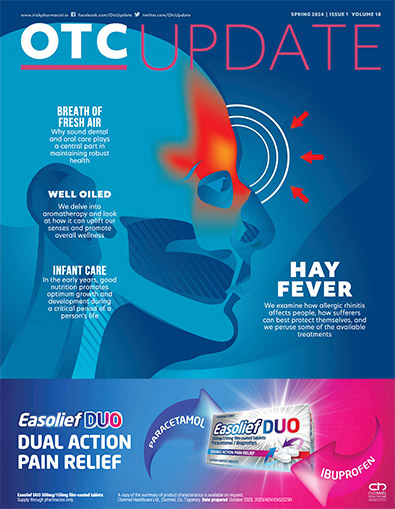Tackling infant pain presents its own particular challenges and the phenomenon has only been scientifically recognised as a real issue in recent decades.
An extra challenge to accurately diagnose arises for pharmacists (and other health professionals) when a parent arrives at the pharmacy with an infant of two-to-12 months old, concerned that their child is in pain and seeking assistance. The normal route, the verbal-based technique of asking the patient themselves questions about their symptoms, is not an option in a child so young. Of course, you can question the parent as regards symptoms or signs that has led them to their conclusion — however, without the input from the person experiencing the pain, the infant — establishing any type of diagnosis could prove challenging. In the case of a first-time parent, they may be quite distressed, as they ‘don’t know what they don’t know’, making their expectation of getting help more acute and immediate, which can bring an added level of pressure to the situation.
With pharmacy being actively promoted as a ‘first port of call’ regarding general healthcare, it’s increasingly likely that you will encounter this difficult scenario at your pharmacy. The purpose of this article therefore is to provide some background information regarding ‘infant pain’ and to help you develop more educated questions and observations that can establish likely causes and subsequent action, or at least allay the immediate fears of a worried parent.
THE NATURE OF INFANT PAIN
Due to the simple fact that infants can’t tell us about the pain they’re experiencing, establishing the nature of infant pain is notoriously difficult. In fact, over 30 years or so, due to their underdeveloped brain and neural pathways, it was debated if infants actually experienced ‘pain’ at all.
In recent decades however, with the advent of technology, it has been proven beyond doubt that infants do experience pain in the same way that adults do. Clinical tests with various stimuli allied to real time MRI and neuro scanning techniques have shown that sensory receptors in infants ‘light up’ to a similar extent to those of adults exposed to the same stimuli. This ongoing research, aimed at improving and measuring infant response to pain medication, along with other research in the field clearly dispels any suggestion that infants do not feel pain.
You might think – ‘How can I help?’ The problem you have is like that faced by every health professional in this area, be it neonatal nurse, paediatrician, consultant — ‘I can’t ask the question’.
In much the same way as a farmer can spot that ‘something’s not right’ in one animal in a group of hundreds — because they know the animal and what is ‘normal behaviour’ — the parents of the infant also know what their infants ‘normal’ signs are in terms of feeding, sleeping, movement, mood, etc, and are therefore best placed to recognise changes in these areas that can help clinicians identify/eliminate possible causes of infant pain.
WARNING SIGNS
The most common causes of infant pain are:
- Teething.
- Infections (especially ear).
- Colic (most often up to four months).
- Pain through colds, flu transmitted at home through contact with others or toys, etc, if there are other children in the house.
As the infant is unable to describe their symptoms, there are signs to look for in several key areas outlined below, some knowledge of which can help you ask relevant questions that can help identify the problem. Behavioural changes could be the first indication of a potential problem and are most likely to be recognised by the parents.
CRYING
As with the farmer above, parents soon come to learn a ‘normal’ cry. It’s the infant’s only way of communicating a variety of needs. Through time, they can distinguish subtle differences in crying that represent being hungry or tired, for example. Maybe it’s discomfort, requiring a nappy change or the infant just needs a cuddle! If an infant is in pain, their cry may (not always) become more high-pitched and extended in duration and will certainly sound different than normal. If this crying cannot be eased by addressing the usual needs, ie, feed, change etc, this may be a reason to investigate further.
Colds, flu, ear infections, stomach bugs, along with viral or bacterial infections, can all cause fever and pain in infants
Colic is a painful intestinal issue, the cause of which is not known. Up to four months old, this prolonged (up to three hours per day) intense crying, especially if it occurs at roughly the same time each day, may be a sign of colic. The infant drawing their legs into the tummy at the same time can further indicate colic.
CHANGES IN APPETITE
If the infant has a ‘healthy’ appetite, (ie, feeds regularly and well, is gaining weight), then instances where food is refused, or feeds missed completely in the case of breast-or bottle-feeding, may be a sign of underlying illness/pain which requires monitoring. Other signs may be that sucking (bottles) has become weaker, or a good latch is not achieved while breastfeeding. Irregularity in feeding routines, fewer soiled or wet nappies, leading to slower weight gain or weight loss, may be a further indication of underlying illness/pain.
FEVER
Colds, flu, ear infections, stomach bugs, along with viral or bacterial infections, can all cause fever and pain in infants. They are particularly susceptible, as their immune systems are underdeveloped. If fever is suspected, check the temperature. Normal temperature should be 37.8°c, however if the temperature is 38°c or above (<12wks old) or above 38.3°c (3-6mths), the doctor should be contacted immediately.
LETHARGY
Infants, by their general nature, are active, bright, inquisitive, alert, and attentive. Any signs of sluggishness, drowsiness or sleeping for longer than usual may be a sign of infection or another underlying condition and should be monitored.
WHAT CAN BE DONE TO HELP?
If pain is suspected, there are several steps, both medicinal and non-medicinal, that can be taken to help alleviate symptoms. Consider advising any of the following:
NON-MEDICAL:
There is significant evidence to indicate that a variety of physical and environmental interactions can help soothe an infant experiencing pain or distress. These can also help the parent who may be experiencing feelings of helplessness in aiding their child.
- Skin-to-skin contact (‘Kangaroo care’) between the parent and child can have a pain-relieving effect and can help reduce stress levels of the parent too.
- Breastfeeding — this promotes skin-to-skin contact with the added proven pain-relieving qualities offered by breast milk. In a clinical setting, for those unable to breastfeed, a 24 per cent sucrose solution administered via dropper onto the tongue also offer pain relief.
- Massaging the infant’s tummy can help relieve tummy pain (not after feeding).
- Holding the infant and moving with a slow, steady, rhythmic rocking movement can help reduce, relieve pain and stress.
- Using distractions such as music, singing, reading stories aloud can help.
- Changing the infant’s immediate environment to something more secure and nest-like can help them feel more contained, warm, and comforted.
MEDICAL
Due to the difficulty in diagnosing pain in infants, especially outside of a hospital neonatal ICU environment, there is only a limited amount that can be offered to a concerned parent by way of medicinal relief over the counter.
IN SUMMARY
As mentioned at the outset, it is increasingly likely that you may encounter infant pain issues at the counter. Hopefully this short article has given you some context to develop the right questions to ask. Within the first 12 months, most mothers and infants are still under the umbrella of GP and post-natal care, so it is likely anything serious would be caught early within that framework.
Almost all infant fevers and pain are non-threatening in nature and willpass in a few days
Almost all infant fevers and pain are non-threatening in nature and will pass in a few days; some points below would necessitate immediate referral to GP:
- Temperature levels outside of those indicated earlier (<3mths – 38°c or above – 38.3°c or above).
- Vomiting.
- Stiff neck.
- Skin discolouration, rash.
- Pain or sickness that’s been going on for more than a couple of days.
- Any difficulty breathing due to coughing or wheezing.
| PARACETAMOL | |||
| Can be given to children in liquid syrup or suppository form from age two months. Regularly used for relief from ear, head or stomach ache. Mostly used to reduce high temperature. | |||
| Paracetamol 120mg/5ml liquid: | |||
| Dosage levels for | 2-6 months | 2.5ml (60mg) | 4 times/24hrs (min 4-hour gap between doses) |
| 6-24 months | 5ml (120mg) | 4 times/24hrs (min 4-hour gap between doses)v |
| IBUPROFEN | ||
| Can be given to children in liquid syrup form from age three months and weighing more than 5kgs. Like paracetamol, regularly used for pain relief and to reduce temperature. Unlike paracetamol, also reduces inflammation. Best avoided in asthmatics due to risk of bronchospasm. | ||
| Ibuprofen 100mg/5ml liquid: | ||
| Dosage levels for | Infants 3-6 months Weighing more than 5 kg | One 2.5ml (50mg) dose 3 times in 24 hours. Do not use for more than 24 hours. |
| Infants 6 months-1 year | 2.5ml (50mg) three to four times a day | |
| Children 1-4 years | 5ml (100mg) three times a day |







